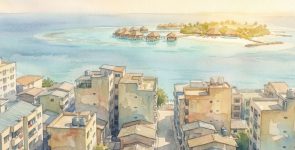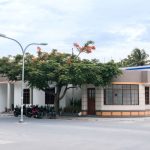
In the Maldives, discussions around economic health frequently hinge on metrics such as GDP growth, tourist arrivals, and foreign investment flows. While these indicators offer useful insights, they fail to capture the wider dimensions of national well-being. Economist Kate Raworth’s “Doughnut Economics” offers a compelling framework—one that advocates for balancing human needs with ecological sustainability.
The Economic Landscape: Achievements and Challenges
Tourism: A Double-Edged Sword
Tourism continues to dominate the Maldivian economy, directly contributing nearly 30% to GDP and generating the lion’s share of foreign exchange. In 2024, the Maldives reported over 2 million tourist arrivals, according to the Ministry of Tourism data. However, while arrival numbers continue to break records, average expenditure per tourist has declined in recent years, limiting the sector’s contribution to broader economic growth.
Moreover, heavy reliance on tourism exposes the country to external shocks—from geopolitical instability to global health crises—highlighting the need for a more balanced economic portfolio.
Fiscal Pressures and Rising Debt
The country’s fiscal position remains under pressure. According to the Maldives Monetary Authority (MMA), the budget deficit stood at approximately 12.8% of GDP in 2024. Public and publicly guaranteed debt was estimated at over MVR 144.98 billion (roughly USD 9.4 billion). This growing debt burden continues to raise concerns about long-term fiscal sustainability, especially given the country’s high dependence on external borrowing and imported goods.
Inflation and the Cost of Living
Headline inflation remained relatively low in the first half of 2024, with MMA reporting annual inflation at 5.1%. However, food prices surged disproportionately, with food inflation surging 6.35% over 12 months. This rise particularly affected low-income households in outer atolls, where limited access to affordable imported goods and fewer livelihood options exacerbate vulnerabilities.
Embracing the Doughnut: A Framework for Sustainable Prosperity
Kate Raworth’s Doughnut Economics framework is built on two concentric boundaries: a social foundation that ensures no one falls short on life’s essentials, and an ecological ceiling that prevents humanity from overshooting the Earth’s limits. For the Maldives, this model is especially relevant.
Social Foundation: Bridging the Gaps
Although the Maldives has made significant progress in several areas of human development, such as education enrolment, literacy, and life expectancy, gaps remain. Access to quality healthcare and public services is uneven across atolls. According to the 2023 Human Development Report, disparities persist between Malé and remote islands, with smaller communities often lacking access to specialist care, diagnostic services, and emergency facilities.
In education, while enrolment in primary and secondary schools remains high, quality and resource allocation still vary significantly across islands. These systemic disparities risk leaving segments of the population below the social foundation envisioned in the Doughnut framework.
Ecological Ceiling: Protecting Fragile Ecosystems
The Maldives is uniquely vulnerable to climate change. Rising sea levels, coral bleaching, and coastal erosion threaten livelihoods, biodiversity, and infrastructure. The country’s coral reefs—integral to tourism and fisheries—have experienced several bleaching events over the past decade, linked to warming ocean temperatures.
Despite some progress, such as initiatives promoting single-use plastic reduction and renewable energy investments, much more remains to be done. The Maldives’ Climate Emergency Act, adopted in 2021, outlines national targets, but implementation has faced delays due to funding and coordination gaps.
Pathways to a Balanced Economy
Diversifying Beyond Tourism
Economic diversification remains a widely endorsed but unevenly executed goal. Fisheries—once the dominant sector—now contribute less than 10% to GDP. Yet opportunities remain in value-added fisheries and aquaculture, especially if infrastructure for cold storage and processing is expanded.
Renewable energy, particularly solar, holds promise for reducing reliance on costly fuel imports, which currently account for a significant share of expenditure. The Ministry of Environment has set targets to generate 33% of energy from renewables by 2028, though progress toward this remains slow.
Fiscal Reforms and Responsible Borrowing
Efforts to enhance tax administration and broaden the revenue base are ongoing. The Maldives Inland Revenue Authority (MIRA) has introduced e-filing systems and compliance measures, but tax collection remains heavily dependent on tourism-related revenues. Broader fiscal reforms—such as rationalising subsidies and reassessing capital expenditure priorities—are essential to restore budgetary space.
The government has also publicly explored options such as debt-for-nature swaps, which would see international creditors forgive a portion of external debt in exchange for environmental conservation commitments. While promising, these proposals remain in the early stages of negotiation and require greater transparency.
Strengthening Public Services
Improving healthcare, education, and social protection is vital to ensuring all Maldivians are lifted above the social floor. Community-specific programmes—particularly for elderly care, maternal health, and disability services—must be prioritised in policy and budget decisions.
Greater investment in digital infrastructure could also help bridge the service gap between Malé and the outer atolls. Telemedicine and remote learning platforms, if supported effectively, could transform access for many underserved communities.
A New Vision of Progress
A healthy economy is not one that grows endlessly, but one that thrives within limits, ensuring dignity, opportunity, and sustainability for all. Growth must be redefined—not merely as increases in income or visitors, but as improvements in collective well-being and resilience.
By reimagining national development through this lens, the Maldives has the opportunity to become not only a success story of small island development but also a beacon for countries seeking a path to prosperity that honours both people and the planet.













